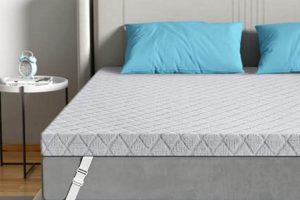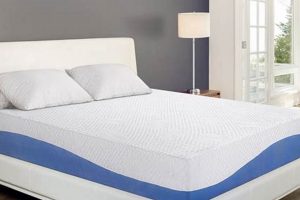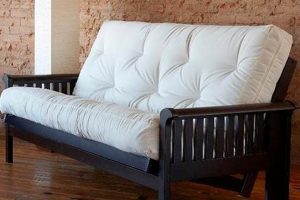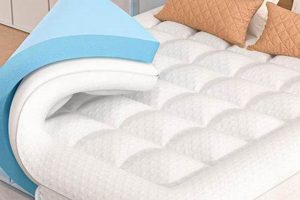A sleeping surface measuring four feet across provides an intermediate width option, suitable for individuals or situations where space is a consideration. This size often bridges the gap between single and larger formats, offering enhanced comfort relative to narrower alternatives.
The utility of such a bed lies in its adaptability. It can efficiently accommodate a single sleeper requiring more room than a standard single bed allows. Furthermore, its dimensions make it a practical choice for guest rooms or smaller living spaces where maximizing floor area is a priority. Historically, similar-sized sleeping arrangements have been employed in various settings, from military barracks to compact apartments, prioritizing function and efficient use of space.
The subsequent sections will delve into specific considerations for selecting the appropriate model, material composition, and support mechanisms relevant to this bed size. Furthermore, this article will explore typical applications, potential advantages, and available accessories.
Considerations for Selecting a 48-Inch Wide Mattress
The following tips provide guidance in choosing the most appropriate model, focusing on factors that impact comfort, support, and longevity.
Tip 1: Measure the Available Space. Prior to purchase, ensure the target room dimensions comfortably accommodate the bed. Allow sufficient clearance around the perimeter for movement and furniture placement. Inadequate space negates any comfort benefits.
Tip 2: Evaluate Sleeper Weight and Size. The bed should provide adequate support based on the intended user’s physical characteristics. Exceeding the mattress’s weight capacity leads to premature sagging and reduced support. Consider a firmer option for heavier individuals.
Tip 3: Research Material Composition. Various materials offer distinct properties. Memory foam conforms to the body, while innerspring designs offer greater bounce and airflow. Latex provides a balance of support and comfort. Assess personal preferences and needs.
Tip 4: Inspect Edge Support. Adequate edge support prevents roll-off and maximizes the usable sleeping surface. Reinforcement along the perimeter is particularly crucial for individuals who tend to sleep near the edge.
Tip 5: Examine Support Structure. The internal support system determines the mattress’s long-term durability. Innerspring systems should feature a high coil count and gauge. Foam mattresses should utilize high-density foam cores to resist compression.
Tip 6: Consider Sleeping Style. Side sleepers typically benefit from softer mattresses that contour to pressure points, while back and stomach sleepers generally require firmer support to maintain spinal alignment.
Tip 7: Read Reviews and Warranties. Independent reviews provide insights into real-world performance and potential issues. A comprehensive warranty protects against manufacturing defects and premature degradation.
Selecting the optimal 48-inch wide mattress involves carefully weighing spatial constraints, personal preferences, and material properties to ensure lasting comfort and support.
The final section of this article will summarize key considerations and offer guidance on maintenance and care to prolong the mattress’s lifespan.
1. Dimensions
The dimension of a 48-inch width dictates the physical footprint and usability of the mattress within a given space. This dimension directly influences room layout, furniture placement, and ease of movement within the bedroom. For instance, a room measuring 10 feet by 10 feet can comfortably accommodate the bed with sufficient perimeter clearance, while a smaller room might feel cramped. Failure to account for this width can result in an impractical and uncomfortable living environment. Therefore, accurate measurement of the room and comparison to the physical size of the sleeping surface are critical pre-purchase activities.
Furthermore, the width impacts the bed’s suitability for different sleepers. While ample for a single adult, the 48-inch dimension may prove inadequate for couples or individuals who prefer expansive sleeping space. This limitation is particularly relevant for restless sleepers who tend to move frequently during the night. The resulting lack of space can disrupt sleep and reduce overall comfort. Consequently, the width dimension interacts directly with the sleeper’s physical size and sleeping habits to determine its practical effectiveness.
In conclusion, the 48-inch width is not merely a numerical descriptor but a fundamental parameter that governs spatial compatibility and sleeper comfort. Recognizing the significance of this dimension, along with its implications for room layout and user experience, ensures a more informed and satisfactory purchase decision. Improper consideration leads to spatial constraints and compromised sleep quality. Therefore, attention to this critical parameter is essential in aligning the mattress to its intended environment and user.
2. Material Composition
The selection of materials in a 48-inch wide mattress critically influences its performance characteristics, including comfort, support, durability, and temperature regulation. Material choice is not arbitrary but should align with intended use and individual sleeper preferences.
- Foam Density and Type
Foam density, measured in pounds per cubic foot, dictates the support and longevity of the mattress. Higher densities resist compression and sagging over time. Options range from polyurethane foam, offering affordability, to memory foam, known for its contouring properties, and latex, valued for its resilience and breathability. The selection directly impacts the mattress’s ability to provide consistent support and withstand prolonged use within the constraints of its 48-inch width.
- Innerspring Coil Count and Gauge
For innerspring constructions, coil count and gauge (wire thickness) are paramount. A higher coil count generally translates to improved support and reduced motion transfer. Lower gauge numbers indicate thicker, more durable coils. The configuration of these components determines the overall support structure within the defined mattress size, influencing its ability to distribute weight evenly and minimize pressure points.
- Cover Fabric and Quilting
The cover fabric, often cotton, polyester, or a blend, contributes to surface comfort and breathability. Quilting patterns influence the initial feel and impact airflow. A breathable fabric, combined with appropriate quilting, aids in temperature regulation, a particularly important consideration within the confined area of a 48-inch wide mattress where heat retention can be more pronounced.
- Fire Retardant Materials
Federal regulations mandate that mattresses meet fire safety standards. Materials such as silica or treated rayon are incorporated to retard flame spread. These additions must not compromise the comfort or durability of the mattress. The integration of these safety features must occur without negatively affecting the overall performance characteristics of the chosen materials.
These interconnected facets of material composition collectively define the quality and performance of the 48-inch wide mattress. Selection necessitates a comprehensive understanding of these properties and their interplay to ensure that the final product aligns with the intended user’s needs and preferences, offering both comfort and durability within the specified dimensions.
3. Support System
The support system is a critical determinant of a 48-inch wide mattress’s performance, directly impacting its comfort, longevity, and ability to promote proper spinal alignment. It is not merely a component but rather the foundational structure dictating the overall quality of the sleeping experience. The effectiveness of this system is paramount within the constraints of this specific width, as inadequate support can exacerbate pressure points and compromise sleep quality.
- Innerspring Coil Configuration
In innerspring mattresses, the coil configuration is a key element of the support system. Coil type (e.g., Bonnell, pocketed), coil gauge (thickness), and coil density (number of coils per unit area) collectively determine the level of support and motion isolation. For example, a higher coil count with individually pocketed coils can minimize motion transfer, a significant benefit for couples or restless sleepers sharing a bed. The configuration needs to be carefully calibrated to provide uniform support across the 48-inch width.
- Foam Core Density and Composition
In foam mattresses, the density and composition of the foam core are crucial. High-density foam offers greater resistance to compression and sagging over time. Different types of foam, such as memory foam, latex, or polyurethane, exhibit varying degrees of firmness, contouring, and responsiveness. A 48-inch wide foam mattress with a high-density core can provide consistent support and prevent the formation of indentations, ensuring lasting comfort.
- Edge Support Reinforcement
Edge support reinforcement is often integrated into the support system to prevent edge collapse and maximize the usable sleeping surface. This feature is particularly important for those who tend to sleep near the edge or sit on the side of the bed. Edge support can be achieved through the use of reinforced coils, high-density foam rails, or a combination of both. Adequate edge support ensures stability and prevents roll-off, enhancing the overall safety and comfort of the 48-inch wide mattress.
- Zoning and Lumbar Support
Zoned support systems incorporate different levels of firmness in specific areas of the mattress to provide targeted support to different parts of the body. Lumbar support, for example, is often enhanced to promote proper spinal alignment. This feature is particularly beneficial for individuals with back pain or those who require extra support in the lumbar region. A well-designed zoned support system can optimize comfort and reduce pressure points, leading to improved sleep quality on the 48-inch wide mattress.
In summary, the support system is a multifaceted aspect of a 48-inch wide mattress, encompassing coil configuration, foam core density, edge support, and zoning. The careful selection and integration of these elements are paramount in determining the mattress’s ability to provide consistent support, promote proper spinal alignment, and ensure lasting comfort. Compromises in any of these areas can significantly impact the overall sleeping experience and reduce the long-term value of the mattress. The support system operates as a crucial component within the specific context of the 48-inch width, directly influencing its performance and suitability for individual needs.
4. Sleeping Position
Sleeping position is a critical determinant of comfort and spinal alignment when utilizing a 48-inch wide mattress. The inherent limitations of the mattress’s width necessitate careful consideration of how different sleeping positions interact with the available space and support characteristics.
- Side Sleeping and Shoulder Accommodation
Side sleeping requires sufficient space for shoulder and hip displacement. On a 48-inch wide mattress, individuals with broad shoulders may find the available space restrictive, potentially leading to discomfort or restricted movement. A mattress with adequate edge support can help maximize the usable sleeping surface, mitigating some of these limitations. However, those with particularly wide frames might experience persistent discomfort due to the limited width.
- Back Sleeping and Spinal Alignment
Back sleeping necessitates proper spinal alignment to prevent back pain and discomfort. The mattress’s firmness should adequately support the natural curvature of the spine. A 48-inch wide mattress may provide ample space for back sleepers to maintain a comfortable position. However, if the mattress is too soft, it may lead to excessive sinking and spinal misalignment. Conversely, a mattress that is too firm may create pressure points. The ideal firmness level is a critical factor for back sleepers using this mattress size.
- Stomach Sleeping and Neck Strain
Stomach sleeping often results in neck strain due to the need to turn the head to one side for breathing. This position typically requires a firmer mattress to prevent excessive sinking of the hips and abdomen, which can exacerbate spinal misalignment. A 48-inch wide mattress may be suitable for stomach sleepers who are able to maintain a relatively straight posture, but it can be problematic if the mattress is too soft or if the individual tends to sprawl out during sleep. Consistent stomach sleeping is generally discouraged due to its potential negative impact on spinal health.
- Combination Sleeping and Adaptability
Combination sleepers, those who shift between multiple positions throughout the night, require a mattress that can adapt to different support needs. A 48-inch wide mattress may present challenges for combination sleepers, as it may not provide sufficient space or support for all positions. A medium-firm mattress with good responsiveness can be a viable option, allowing for adjustments in position without compromising support. However, restless sleepers might still find the limited width constricting.
In summary, the interaction between sleeping position and a 48-inch wide mattress hinges on individual body dimensions, sleeping habits, and mattress characteristics. The inherent width limitations of this mattress size necessitate careful consideration of these factors to ensure optimal comfort and spinal alignment. While some sleeping positions may be more easily accommodated than others, the selection of the appropriate mattress firmness and support features is crucial in maximizing the potential benefits and minimizing the potential drawbacks of this specific mattress size. Individuals with larger frames or those who prefer expansive sleeping space may find the 48-inch width overly restrictive, regardless of sleeping position.
5. Room size
The dimensions of a room are inextricably linked to the suitability of a 48-inch wide mattress. A room too small will render the mattress disproportionately large, hindering movement and diminishing the overall functionality of the space. Conversely, a room excessively large will make the mattress appear insignificant, potentially impacting the aesthetic balance and creating a sense of emptiness. The relationship is causal: room size dictates the practicality of incorporating the bed size. For example, in a 8×8 foot room, a bed this size might leave only narrow pathways, impeding daily activities, while in a 12×12 foot room it would be more proportional, allowing space for other furniture.
Room size dictates practical applications, influencing the comfort and utility of the living space. Efficient use of space necessitates careful planning. The presence of doors, windows, and heating vents further constrains placement options. An understanding of these spatial limitations is paramount. Consider a studio apartment: every square foot counts. A 48-inch mattress might be ideal for single occupancy, maximizing sleeping space while leaving room for a small desk and seating area. This understanding highlights the need to pre-measure the space and carefully consider other furnishings to assure compatibility, improving workflow and reducing inconvenience.
In summary, the connection between room size and the appropriateness of a 48-inch wide mattress is vital for achieving spatial harmony and functional efficiency. Neglecting this relationship leads to cramped conditions, limited mobility, and compromised aesthetics. Accurate assessment of the room dimensions is therefore crucial to ensuring the selected mattress complements and enhances the overall living environment. Prioritizing this ensures a more comfortable and aesthetically pleasing outcome.
6. Weight capacity
Weight capacity is a critical parameter defining the structural integrity and long-term performance of a 48-inch wide mattress. It represents the maximum load a mattress can support without compromising its support characteristics or accelerating material degradation. Exceeding this limit precipitates premature sagging, reduced comfort, and compromised spinal support.
- Core Material Density and Weight Distribution
The density of the mattress core material, whether foam or innerspring, directly influences its weight-bearing capabilities. Higher density materials offer greater resistance to compression and can support heavier loads. Inadequate density leads to uneven weight distribution, creating pressure points and reducing overall comfort. The specific design of a 48-inch wide mattress must account for these factors to ensure uniform support across the sleeping surface.
- Innerspring Coil Gauge and Count
For innerspring mattresses, the gauge (thickness) and count of the coils determine the overall support system’s robustness. Lower gauge numbers signify thicker, more durable coils capable of withstanding greater weight. A higher coil count distributes weight more evenly, reducing stress on individual coils. Within the 48-inch width constraint, a carefully engineered innerspring system must balance coil gauge and count to achieve optimal weight capacity.
- Edge Support and Perimeter Reinforcement
Edge support reinforcement is crucial for preventing edge collapse and maximizing the usable sleeping surface, particularly under heavy loads. Robust edge support, achieved through high-density foam rails or reinforced coils, distributes weight evenly and prevents roll-off. This feature is particularly important in a 48-inch wide mattress where the edges are more easily accessible and subject to increased pressure.
- Foundation Compatibility and Load Transfer
The type of foundation used beneath the mattress influences its overall weight-bearing capacity. A solid, supportive foundation distributes weight evenly across the entire mattress surface, preventing localized stress points. Conversely, a weak or improperly designed foundation can concentrate weight, leading to premature sagging and reduced lifespan. Proper foundation selection is essential for maximizing the weight capacity and longevity of a 48-inch wide mattress.
The interplay of core material density, innerspring coil characteristics, edge support, and foundation compatibility dictates the overall weight capacity of a 48-inch wide mattress. Selecting a mattress with an appropriate weight capacity, based on the intended user’s weight and sleeping habits, is crucial for ensuring lasting comfort, support, and durability. Exceeding the specified weight limit compromises these attributes and accelerates mattress degradation, negating any initial cost savings.
7. Budget
Budgetary considerations exert a significant influence on the selection of a 48-inch wide mattress, dictating the available range of materials, construction techniques, and feature sets. Lower budgets typically restrict choices to basic innerspring or lower-density foam mattresses, often lacking enhanced support features or premium materials. Conversely, higher budgets afford access to more sophisticated options, including memory foam, latex, hybrid constructions, and advanced features such as zoned support and enhanced edge reinforcement. This correlation between budget and available features directly impacts comfort, durability, and long-term satisfaction. As an example, a budget of $200 might only allow for a basic innerspring model with a limited lifespan, while a budget of $500 could secure a higher-quality foam mattress with improved support and longevity.
The importance of budget extends beyond the initial purchase price. It affects the overall cost of ownership, considering factors such as mattress lifespan and potential replacement frequency. A cheaper mattress with a shorter lifespan will necessitate more frequent replacements, ultimately exceeding the cost of a more expensive, durable option. Furthermore, budget constraints may limit access to mattresses with hypoallergenic materials or features designed to alleviate specific health concerns. For instance, individuals with allergies might be unable to afford mattresses with certified hypoallergenic properties, potentially exacerbating their symptoms. Therefore, a comprehensive budgetary analysis should incorporate long-term costs and potential health implications, not solely focus on the initial purchase price.
In summary, budgetary limitations directly shape the available selection of 48-inch wide mattresses, impacting material quality, construction techniques, and feature sets. While lower budgets may provide immediate cost savings, they often compromise comfort, durability, and long-term value. A balanced approach involves considering not only the initial price but also the long-term costs, potential health implications, and overall value proposition to ensure the selected mattress aligns with both financial constraints and individual needs. Addressing the selection ensures a comfortable and economically viable resolution, and recognizing the relationship is essential for the practical significance of the choice.
Frequently Asked Questions About 48-Inch Wide Mattresses
The following section addresses common inquiries and concerns regarding mattresses of this size. The information provided is intended to clarify their suitability and application in various contexts.
Question 1: Is a 48-inch wide mattress suitable for two adults?
Generally, this width is not recommended for two adults. The limited space may restrict movement and compromise sleep quality for both individuals. This size is better suited for single sleepers who desire more space than a standard twin mattress provides.
Question 2: What are the common dimensions of a 48-inch wide mattress?
While the width is fixed at 48 inches, the length typically corresponds to that of a full or double mattress, measuring 75 inches. However, variations may exist depending on the manufacturer. Verifying dimensions before purchase is advisable.
Question 3: What type of foundation is recommended for this mattress size?
A solid, supportive foundation is recommended. Options include platform beds, box springs, or adjustable bases. The foundation should provide even support across the entire mattress surface to prevent sagging and prolong its lifespan.
Question 4: What is the typical weight capacity of a 48-inch wide mattress?
Weight capacity varies depending on the materials and construction. However, most models are designed to support at least 250 pounds. Exceeding the specified weight limit can damage the mattress and compromise its support characteristics. Consulting the manufacturer’s specifications is recommended.
Question 5: What are the benefits of a 48-inch wide mattress compared to a standard twin?
The increased width provides additional sleeping space, allowing for greater freedom of movement and improved comfort. This size is particularly beneficial for single sleepers who prefer more room or tend to toss and turn during the night.
Question 6: Where can one typically purchase this mattress size?
Many mattress retailers, both online and brick-and-mortar stores, offer this size. However, selection may be more limited compared to standard sizes such as twin, full, queen, and king. Checking with specialty mattress stores or online retailers with a wide selection is recommended.
In summary, this FAQ section offers clarifications regarding the application, dimensions, and suitability of 48-inch wide mattresses, thereby enabling a more informed purchase decision.
The subsequent section will provide a conclusive overview of the key considerations discussed throughout this article.
Conclusion
This article has presented a comprehensive examination of the 48 inch wide mattress, detailing its dimensions, material compositions, support systems, and suitability for various sleeping positions and room sizes. Key considerations include weight capacity, budgetary constraints, and the interplay between these factors in determining overall value and long-term satisfaction. Furthermore, frequently asked questions were addressed to clarify common concerns and misconceptions regarding this specific mattress size.
The selection of a sleep surface four feet in width demands careful evaluation of individual needs and spatial limitations. Neglecting these parameters can result in compromised comfort, reduced support, and ultimately, an unsatisfactory sleeping experience. Therefore, a judicious and informed approach is paramount to maximizing the potential benefits of a 48 inch wide mattress. Future research may explore advancements in material technology and ergonomic design that further enhance the performance and suitability of mattresses within these dimensional constraints.


![Best 6 Inch Twin Memory Foam Mattress [Guide & Review] Organic & Natural Mattress Buyer’s Guide: Non-Toxic Sleep Solutions Best 6 Inch Twin Memory Foam Mattress [Guide & Review] | Organic & Natural Mattress Buyer’s Guide: Non-Toxic Sleep Solutions](https://mattressworldpa.com/wp-content/uploads/2025/07/th-3676-300x200.jpg)




![Elevated Comfort: 24 Inch High Air Mattress - [Brand] Organic & Natural Mattress Buyer’s Guide: Non-Toxic Sleep Solutions Elevated Comfort: 24 Inch High Air Mattress - [Brand] | Organic & Natural Mattress Buyer’s Guide: Non-Toxic Sleep Solutions](https://mattressworldpa.com/wp-content/uploads/2025/07/th-3671-300x200.jpg)